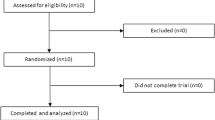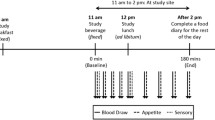Abstract
Purpose
Inulin-type fructans are recognized as prebiotic dietary fibres and classified as non-digestible carbohydrates that do not contribute to glycaemia. The aim of the present studies was to investigate the glycaemic response (GR) and insulinaemic response (IR) to foods in which sucrose was partially replaced by inulin or oligofructose from chicory.
Methods
In a double-blind, randomized, controlled cross-over design, 40–42 healthy adults consumed a yogurt drink containing oligofructose or fruit jelly containing inulin and the respective full-sugar variants. Capillary blood glucose and insulin were measured in fasted participants and at 15, 30, 45, 60, 90, and 120 min after starting to drink/eat. For each test food, the incremental area under the curve (iAUC) for glucose and insulin was calculated and the GR and IR determined.
Results
Consumption of a yogurt drink with oligofructose which was 20% reduced in sugars significantly lowered the glycaemic response compared to the full-sugar reference (iAUC120min 31.9 and 37.3 mmol/L/min, respectively; p < 0.05). A fruit jelly made with inulin and containing 30% less sugars than the full-sugar variant likewise resulted in a significantly reduced blood glucose response (iAUC120min 53.7 and 63.7 mmol/L/min, respectively; p < 0.05). In both studies, the postprandial insulin response was lowered in parallel (p < 0.05). The reduction of postprandial glycaemia was positively correlated to the proportion of sugars replaced by inulin-type fructans (p < 0.001).
Conclusions
In conclusion, the studies confirmed that substitution of glycaemic sugars by inulin or oligofructose from chicory may be an effective strategy to reduce the postprandial blood glucose response to foods.



Similar content being viewed by others
References
Blaak EE, Antoine JM, Benton D et al (2012) Impact of postprandial glycaemia on health and prevention of disease. Obes Rev 13(10):923–984
Ludwig D (2002) The glycaemic index: physiological mechanisms relating to obesity, diabetes, and cardiovascular disease. JAMA 287(18):2414–2423
Cavalot F, Petrelli A, Traversa M et al (2006) Postprandial blood glucose is a stronger predictor of cardiovascular events than fasting blood glucose in type 2 diabetes mellitus, especially in women: lessons from the San Luigi Gonzaga Diabetes Study. J Clin Endocrinol Metab 91(3):813–819
Rendell MS, Jovanovic L (2006) Targeting postprandial hyperglycemia. Metab Clin Exp 55(9):1263–1281
Woerle HJ, Neumann C, Zschau S et al (2007) Impact of fasting and postprandial glycemia on overall glycemic control in type 2 diabetes: importance of postprandial glycemia to achieve target HbA1c levels. Diabetes Res Clin Pract 77(2):280–285
Roberfroid M, Slavin J (2000) Nondigestible oligosaccharides. Crit Rev Food Sci Nutr 40(6):461–480
Ellegård L, Andersson H, Bosaeus I (1997) Inulin and oligofructose do not influence the absorption of cholesterol, or the excretion of cholesterol, Ca, Mg, Zn, Fe, or bile acids but increases energy excretion in ileostomy subjects. Eur J Clin Nutr 51(1):1–5
Schaafsma G, Slavin L (2015) Significance of inulin fructans in the human diet. Comp Rev Food Sci Food Safety 14(1):37–47
Franck A (2002) Technological functionality of inulin and oligofructose. Br J Nutr 87(Suppl 2):S287–S291
Meyer D (2007) Dietary fibre: components and functions: inulin for product development of low GI products to support weight management. Wageningen Academic Publishers, Roosendaal
Grysman A, Carlson T, Wolever T (2008) Effects of sucromalt on postprandial responses in human subjects. Eur J Clin Nutr 62(12):1364–1371
Tarini J, Wolever T (2010) The fermentable fibre inulin increases postprandial serum short-chain fatty acids and reduced free-fatty acids and ghrelin in healthy subjects. Appl Physiol Nutr Metab 35(1):9–16
EFSA NDA Panel (2014) Scientific opinion on the substantiation of a health claim related to non-digestible carbohydrates and a reduction of post-prandial glycaemic responses pursuant to Article 13(5) of Regulation (EC) No 1924/2006. EFSA J 12(1):3513
European Commission–Commission Implementing Regulation (EU) 2016/854 authorising certain health claims made on foods, other than those referring to the reduction of disease risk and to children’s development and health and amending Regulation (EU) No 432/2012
ISO food products–determination of the glycaemic index (GI) and recommendation for food classification (26642:2010)
EFSA NDA Panel (2012) Guidance on the scientific requirements for health claims related to appetite ratings, weight management, and blood glucose concentrations. EFSA J 10(3):2604
Hätönen KA, Simila E, Virtamo JR et al (2006) Methodologic considerations in the measurement of glycemic index: glycemic response to rye bread, oatmeal porridge, and mashed potatoe. Am J Clin Nutr 84(5):1055–1061
Siahanidou T, Margeli A, Kappis A et al (2011) Circluating vasfatin levels in healthy preterm infants are independently associated with high-density lipoprotein cholesterol levels and dietary long-chain polyunsaturated fatty acids. Metabolism 60(3):389–393
Atkinson F, Foster-Powell K, Brand-Miller J (2008) International tables of glycemic index and glycemic load values. Diabetes Care 31(12):2281–2283
Brynes AE, Edwards CM, Ghatei MA et al (2003) A randomised four-intervention crossover study investigating the effect of carbohydrates on daytime profiles of insulin, glucose, non-esterified fatty acids and triacylglycerols in middle-aged men. Br J Nutr 89(2):207–218
Wolever TM, Jenkins DJ, Vuksan V et al (1992) Beneficial effect of a low glycaemic index diet in type 2 diabetes. Diabet Med 9(5):451–458
Venn B, Green T (2007) Glycemic index and glycemic load: measurement issues and their effect on diet-disease relationships. Eur J Clin Nutr 61 (Suppl 1):S122–S131
Aziz A, Dumais L, Barber J (2013) Health Canada’s evaluation of the use of glycemic index claims on food labels. Am J Clin Nutr 98(2):269–274
European Commission–Regulation (EC) No. 1924/2006 of the European Parliament and of the council of 20 December 2006 on nutrition and health claims made on foods
Kellow N, Coughlan M, Reid C (2014) Metabolic benefits of dietary prebiotics in human subjects: a systematic review of randomised controlled trials. Br J Nutr 111(7):1147–1161
Dehghan P, Pourghassem Gargari B, Asghari Jafar-abadi M (2014) Oligofructose-enriched inulin improves some inflammatory markers and metabolic endotoxemia in women with type 2 diabetes mellitus: a randomized controlled clinical trial. Nutrition 30(4):418–423
Dehghan P, Pourghassem Gargari B, Asghari Jafar-abadi M et al (2014) Inulin controls inflammation and metabolic endotoxemia in women with type 2 diabetes mellitus: a randomized-controlled clinical trial. Int J Food Sci Nutr 65(1):117–123
Jones JM (2014) CODEX-aligned dietary fiber definitions help to bridge the ‘fiber gap’. Nutr J 13:34
Clemens R, Kranz S, Mobley AR et al (2012) Filling America’s fiber intake gap: summary of a roundtable to probe realistic solutions with a focus on grain-based foods. J Nutr 142(7):1390S–1401S
Deehan EC, Walter J (2016) The fiber gap and the disappearing gut microbiome: implications for human nutrition. Trends Endocrinol Metab 27(5):239–242
Acknowledgements
We thank all participants for their time and effort. Furthermore, we would like to thank the product development department of CRDS Südzucker for the development and production of test samples (yogurt drinks, fruit jellies).
Author contribution statement
All authors were involved in the development of the study protocol. H. Lightowler and S. Thondre were responsible for data collection, data analysis, and interpretation of the data. A Holz and S Theis wrote the initial draft of the manuscript. All the authors read, commented upon, and made a significant contribution to the submitted manuscript.
Author information
Authors and Affiliations
Corresponding author
Ethics declarations
Conflict of interest
Both studies were funded by BENEO GmbH (a member of the Südzucker Group), Cosucra-Groupe Warcoing S.A. and Sensus B.V. The funding companies reserve the exclusive right to use the results and data for regulatory proceedings and health claim requests. The yogurt drinks and fruit jellies were specially developed for this study and produced by BENEO/CRDS Südzucker. A. Holz and S. Theis are employees of BENEO/Südzucker Group.
Rights and permissions
About this article
Cite this article
Lightowler, H., Thondre, S., Holz, A. et al. Replacement of glycaemic carbohydrates by inulin-type fructans from chicory (oligofructose, inulin) reduces the postprandial blood glucose and insulin response to foods: report of two double-blind, randomized, controlled trials. Eur J Nutr 57, 1259–1268 (2018). https://doi.org/10.1007/s00394-017-1409-z
Received:
Accepted:
Published:
Issue Date:
DOI: https://doi.org/10.1007/s00394-017-1409-z




